Bouquets To Art Returns to the de Young Museum in San Francisco
By Jill Brooke

Bouquets to Art is now in bloom at San Francisco’s de Young Museum.
Over 800,000 visitors are expected to walk through the museum and experience the floral artistry of such stars as Natasha Lisitsa of Waterlily Pond, Kirk Wilder of Acme Floral Company, Joy Somersett of Miss Scarlett’s Flowers and more than 110 other esteemed professionals.
Now in its 35th year, Bouquets to Art follows similar celebrations in other museums such as the North Carolina Museum of Art and the Museum of Fine Arts in Boston, which have incorporated the idea in their yearly calendars. These events draw huge crowds – after all flowers make people happy – and millions of dollars are raised to help underwrite educational programs and exhibitions.
According to Shaquille Heath, a communications associate for the San Francisco museum, each floral artist was given the choice of what painting, sculpture or mural to interpret through flowers.
In San Francisco, you can tell that this is very much a tech environment where futuristic concepts and complex math is revered. More than 18 of Fortune 500 companies are based in the Bay Area including Oracle and Facebook. People who live and work in this area are encouraged to consider contemporary models and the art here represents that sensibility.
Certainly, Natasha Lisitsa and Daniel Schultz’ dazzling display, which greeted guests in Wilsey Hall, represented the future. Named “Eclipse” this floral art was inspired by the technical drawings and geometric forms of the mural “Between Sign and Subject” by Matt Mullican.
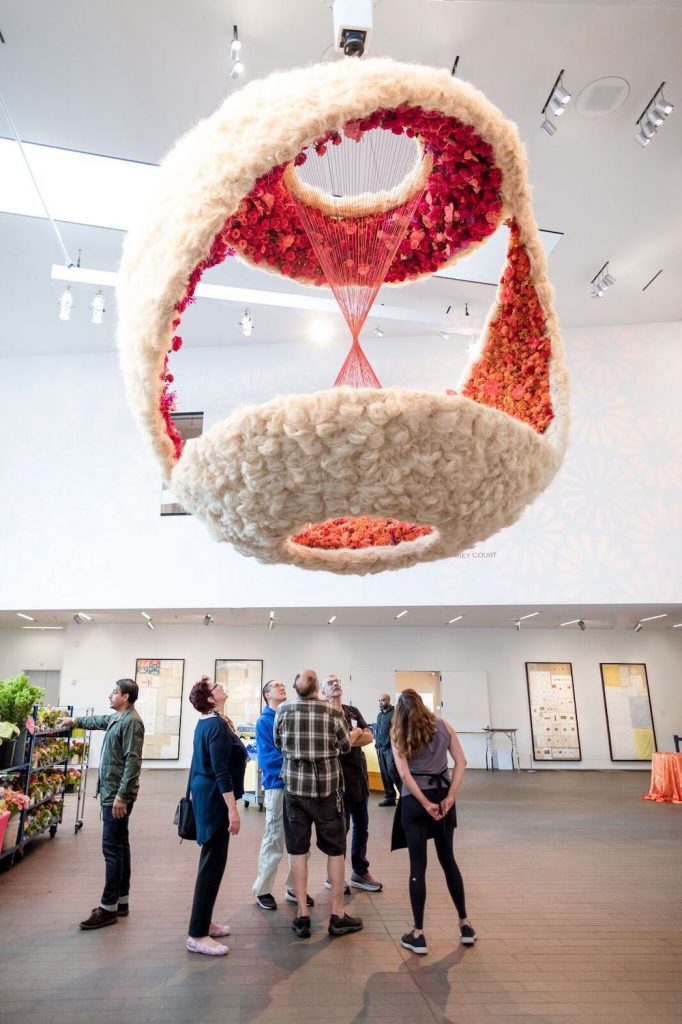
As Lisitsa explained, it is geometry in motion – a deconstructed sphere rotating and continually eclipsing itself, mesmerizing the viewer with different overlapping perspectives of two halves of a whole.
“The yin yang,” explains Lisitsa, who runs Waterlily Pond. Weighing 1,200 pounds, the work required her team to use 60 pounds of sisal fiber, 1,200 feet of colored string and 500 feet of aluminum. The final work is 14 feet in diameter.
“We had to create something that can last eight days in the air,” says Lisitsa. With that challenge, she chose to keep the selection of different flowers to a minimum – mainly Gerbera daisies, orchids and carnations. “We are using 10,000 flowers for this display and we want to keep them alive,” she says, noting how her team must use a lift to water the flowers and maintain them.
Other florists had an easier time maintaining their creations while also choosing a modern sensibility.
Gabriela Reid of Colorful Events showed how to present flowers almost like a meal. She took the colors of Artine Miller’s swirling modern “Dragon Jewel” tapestry and made something small but appetizing. As my mother always said, less is more. That rarely is the case with flowers but this is a rare exception. It had a dainty modernism to it that was interesting. Not dazzling, but interesting.
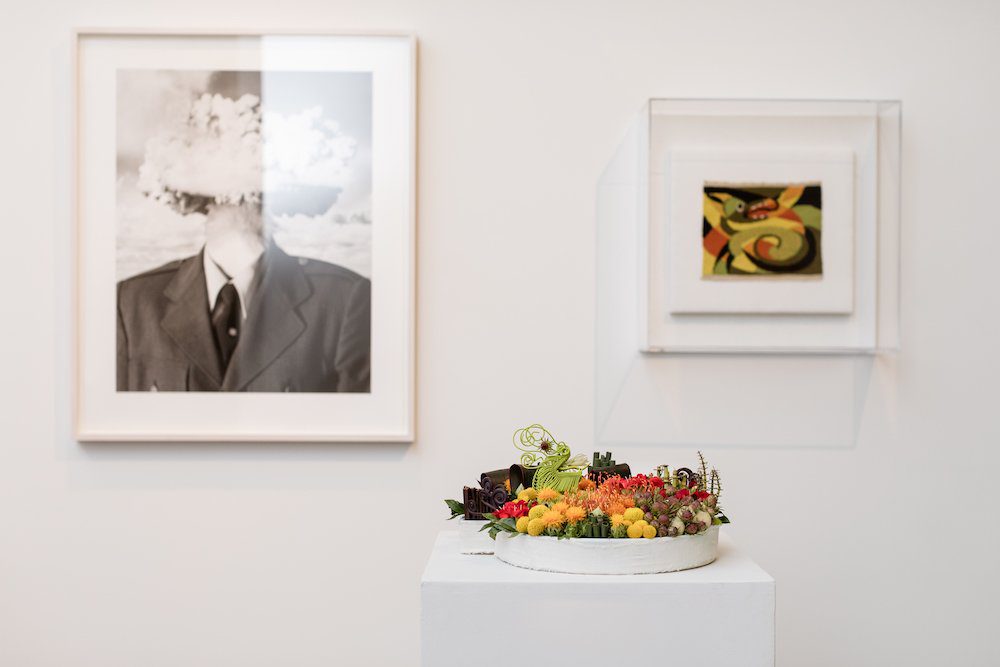
Kirk Wilder of Acme Floral Company tickled my funny bone with his inspired creation from Nick Cave’s sculpture. His display was a friendly puppy created with “30 bunches of white button mums.”
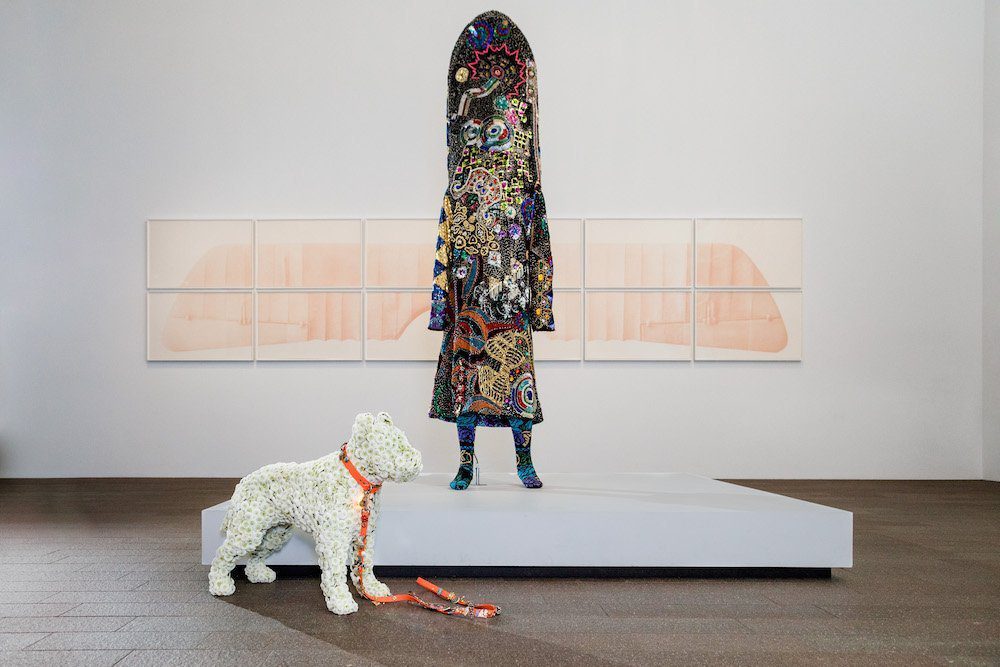
“The thought process was pretty simple,” explained Wilder. “I think it’s best to add to and collaborate with the art we are paired with. For me, this was the dog that this amazing sculpture is taking for a walk. Nick Cave’s sound suits are inspired, outlandish and ethereal and I think the flower-covered canine offsets it nicely. The leash is embellished with found bits and bobbles of lapel pins and found jewelry for a touch of bling on the white-on-white, mum-covered dog.”
This is a floral display you will fall in love with.
Dandelion Seeds Floral Art Salon‘s Olena Tcaci chose a rainbow of vases to illustrate her selection. Her blooms – especially the orchids – had a movement that contrasted nicely with the structured lines of the Frank Stella painting “Letre sur les aveugles II, 1974.”
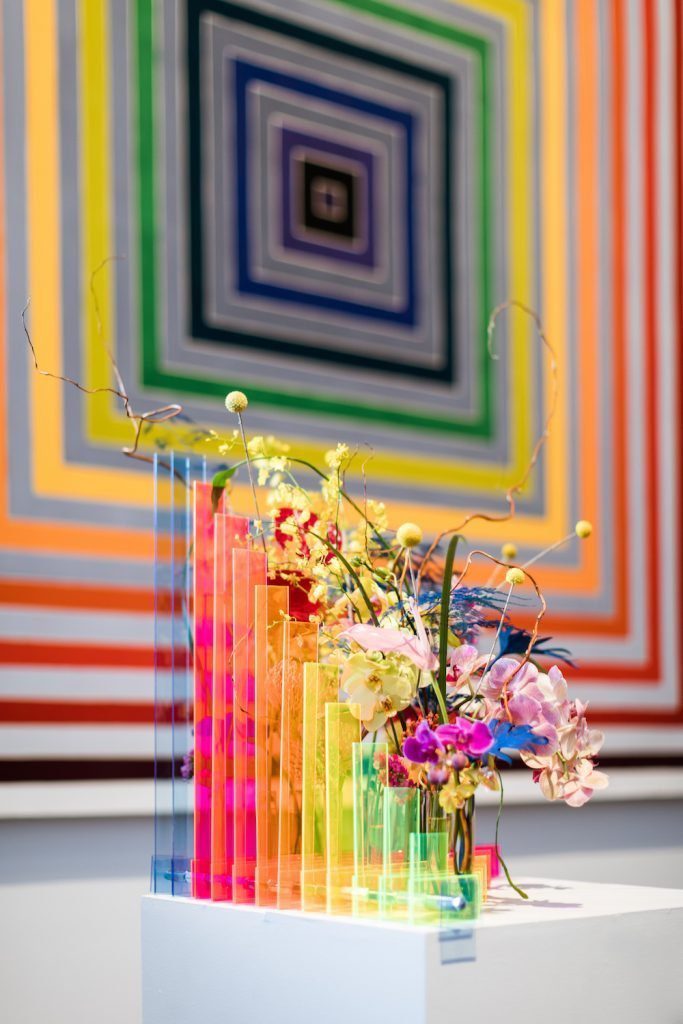
Garden Party’s Amy Romano Vassar’s choice was one Morticia Adams would have embraced. It was ominously dark, but clever. Her use of a shelf to have ebony flowers in small pots lined up and then another shelf with dangling rusty brown vines complemented the Louise Nevelson artwork “Sky Cathedral’s Presence I.”
I wouldn’t want it in my house, but maybe director Tim Burton would.

Using cardboard, tissue paper, tying twine, wire, and water tubes, Kiwi DeVoy made his display textural to match the Robert Rauschenberg “Cardbird II” painting. DeVoy said she wanted to work “with the seemingly humble, simple, and rough materials of the original work. The challenge was to acknowledge these materials, realize the complexity of the original, and reflect and expand that into a significant floral interpretation. It was very important to me to honor the essence of the original while staying true to my own sophisticated style.” Flowers used in this installation were anthurium, alstroemeria, oncidium, James Story orchids, hypericum, calla lilies, protea, and holly fern.
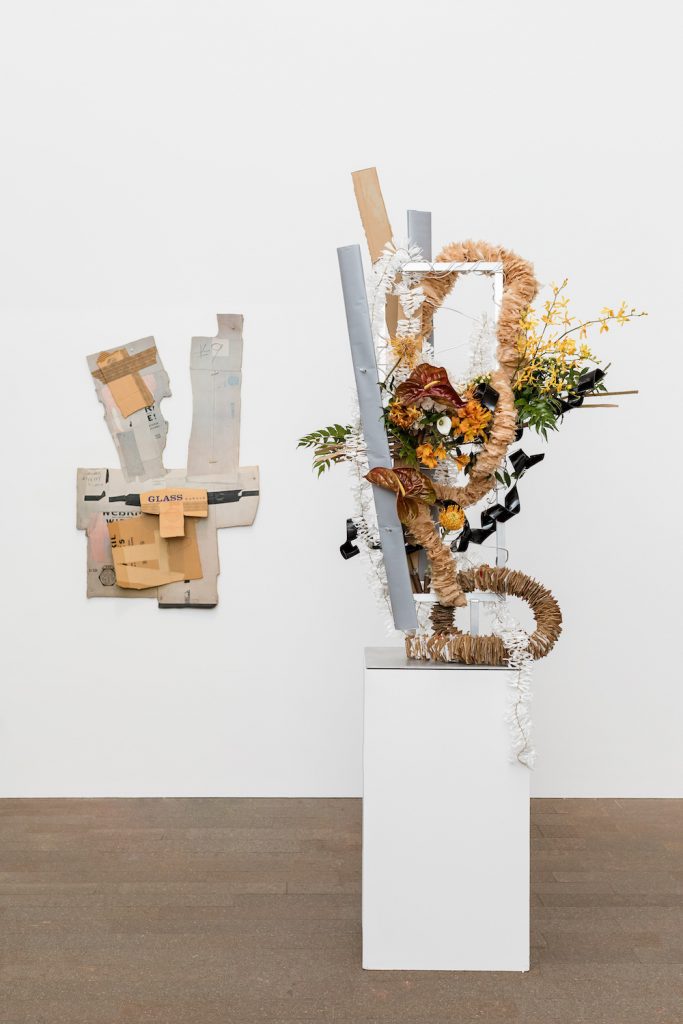
As someone who is more a classist with a dash of daring, I was very much drawn to the work of Joy Somersett of Miss Scarlett’s Flowers.
Turns out that Somersett often chooses classic paintings because she is searching for the opportunity to pop a bouquet into the display and it’s easier to achieve that objective when you have a painting of the female form. This year she chose William Merritt Chase’s “Portrait of Miss D,” 1900
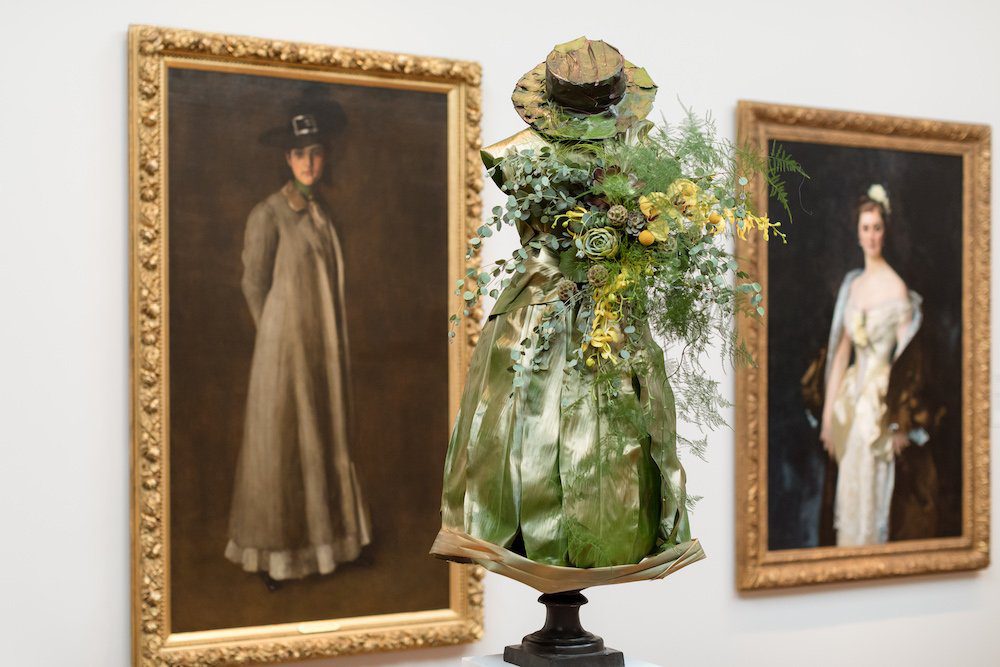
“I specialize in weddings so I want to think of a way I can get a bouquet into someone’s hand,” explains Somersett. “I tried to create something that was whimsical and light-hearted.”
The skirt of her floral sculpture was made of Hawaiian ti leaves and flax leaves which were dusted with gold. The hat was made of galax leaves. The bouquet had three different orchids, along with succulents and Italian ruckus. Her cymbidium orchid, including a yellow one with a burgundy throat, was particularly pretty.
Others also used traditional paintings to create their displays resulting in a large variety of floral creativity that literally takes your breath away such as Cathy Boldt’s interpretation of Florine Stettheimer, “Still Life with Flowers,” 1921.
I liked this one because it’s still nice to see a beautiful vase of flowers.
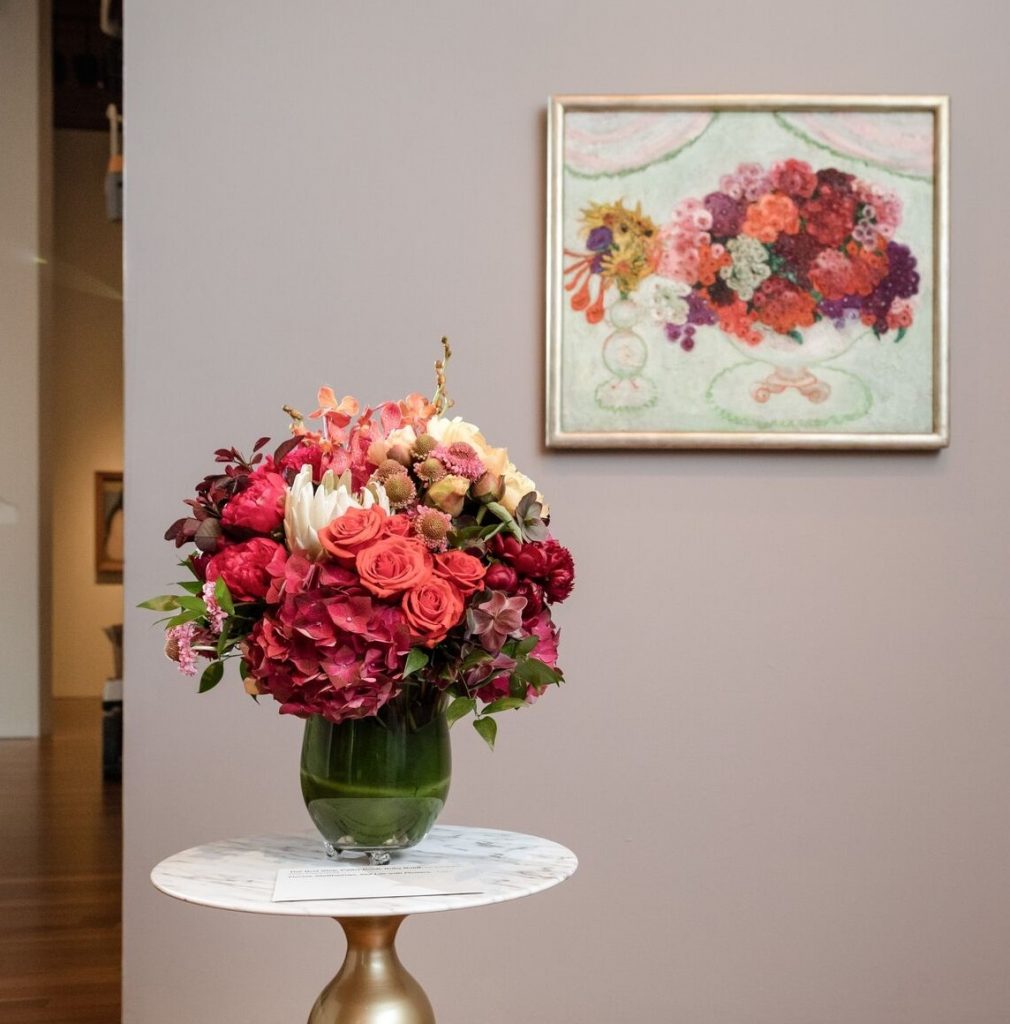
As we say here at Flower Power With Jill, and it is our mission, floral artists deserve the same respect as any emerging painter. It’s actually a harder job to do because these artists are working with perishable materials while paint lasts centuries.
It is a love of nature that propels these floral artists to create these veritable masterpieces. Thanks to the tech advancements made in this area, luckily, all of us can enjoy digital images of their work.
Photography by Gary Sexton. Images courtesy of the Fine Arts Museums of San Francisco.
